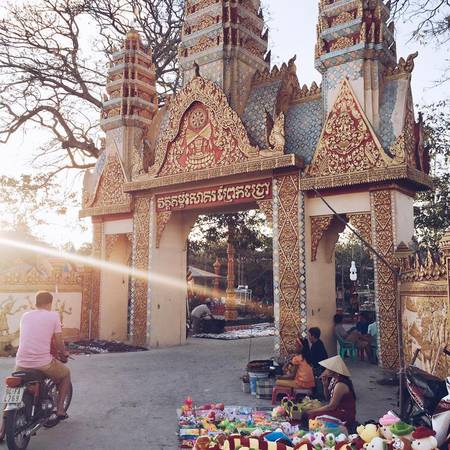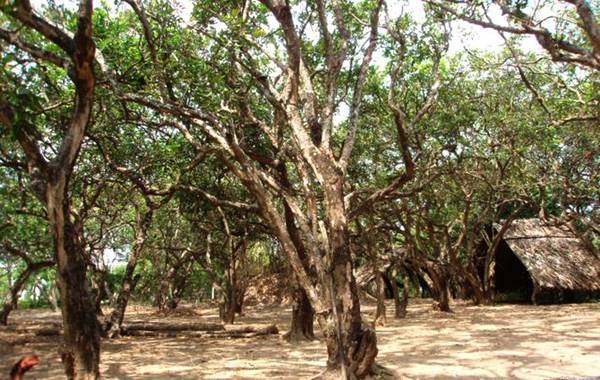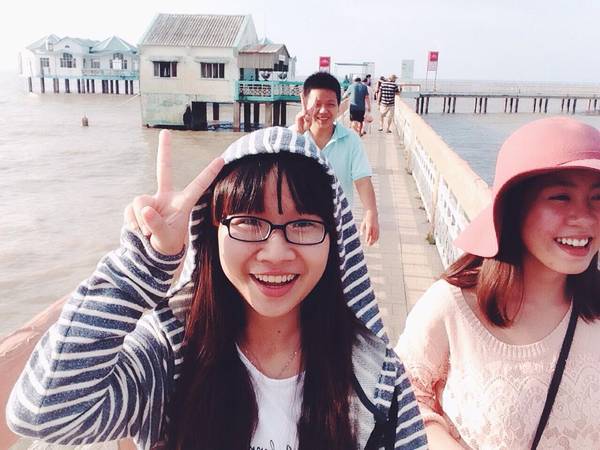In the past, Bac Lieu was known as the land of debauchees, and the most popular anecdote was that of the “Bac Lieu dude”, who was very rich and open-handed at that time. This land attracted many rich landowners who moved there to build their own residences.
Today, tourists visiting Bac Lieu will be impressed by the luxurious and elegant Western-style buildings. The buildings include the villa of Bac Lieu Mandarin's son, which stands along the river, and other buildings situated in the Hang Me Park, such as the Administration House, the court, the Bo mansion (the building of the head mandarin), the Son quarter official building, and Dong Trach. Presently, these buildings are used for the provincial Library, the People’s Court of Investigation, and the office for the Bac Lieu Newspaper.
Tourists also can visit the Bac Lieu Bird Reserve, Vinh Hung Ancient Tower, Xiem Can Pagoda and longan gardens or discover the mangrove forest.
The Khmer organize the Dang Bong Ceremony to raise money for construction of a bridge, road, school, pagoda, or other public projects. They also hold the ceremony to commemorate their deceased friends and family members.
Bac Lieu is 280km from Ho Chi Minh City, 67km from Ca Mau, 50km from Soc Trang, and 113km from Can Tho. The National Highway No. 1A crosses the province and links to Soc Trang and Ca Mau province.
Here are the top destinations in Bac Lieu:
Minh Pagoda

Traveling to Bac Lieu, tourists will have the chance to visit Minh Pagoda, featuring the Chinese palatial architecture style of the pre-Ming dynasty. The three-door temple gates are carefully carved from stones.
Minh Pagoda is located at Ward 3, Bac Lieu town, Bac Lieu province. The pagoda was established by a group of people called Minh Huong led by Tran Thiet Thuan, the headman of Vinh Huong village. The construction started in 1890 and was completed in 1923.
The pagoda features a Chinese palatial architecture style from the pre-Ming dynasty. The three-door temple gates are carefully carved from stones.
The two main pillars are carved with sophisticated patterns: dragons, clouds, and wine gourds following the posture of a dragon shrouded in mist.
At the facade of the pagoda, walls are banked with many scenes of palatial ancient daily life. You can see a precisely carved lacquered board hanging at the entrance gate; this board was donated by the Phuc Kien people in 1922.
There are many precious items such as copper incense and 16 types of weapons of the tutelary gods.
The central chamber worships a huge statue, featuring a man wearing his court dress. The worship plaque is decorated with wonderful patterns, featuring two dragons attending to the Moon, and sophisticated patterns of apricot, orchid, daisy, ivory bamboo, pine trees. On the right hand side is the worship place for Mr. Bon (Bon Dau Cong Cong). On the left hand side is the worship place for talented people who spent their lives reclaiming the land.
Minh pagoda has great traditional and cultural value, especially for local people. For tourists, this is a sacred place where they can feel undisturbed and relaxed.
Western villa complex

The early 20th century Western-style buildings including 30 mansions and villas left standing along the two banks of the river in Bac Lieu have become part of the heritage and the pride of Bac Lieu people.
Unlike many other provinces, such as Can Tho and An Giang, there are still many western-style buildings including the villa of Bac Lieu Mandarin’s son, which stands along the river, and other buildings in the Hang Me Park, such as the Administration House, the court, the Bo Mansion (the building of the head mandarin) the Son quarter official building, and Dong Trach. These buildings are used for the provincial Library, the People's’ Court of Investigation, and the office for the Bac Lieu Newspaper.
The construction materials, including steel, marble, tile, and brick, were all imported from France. The 20th century Western –style buildings have spacious surroundings, symmetrical architecture, and tile-covered roofs. The roofs are octagonal, and the supporting rafters look somewhat like those in a pagoda. The old villas and mansions of Bac Lieu have their own style, unlike French villas in Hanoi, Ho Chi Minh City or Dalat.
In general, they feature high ceilings; their exteriors are washed with yellow paint; and they have high vault-like roofs.
Xiem Can - largest pagoda in Bac Lieu

At the distance of 7km from the town of Bac Lieu, Xiem Can Pagoda is located on the same road leading to the Bac Lieu Bird Sanctuary. Visiting the pagoda, tourists will not only be impressed by its imposing, splendid beauty, but also by the great hospitality of the local people.
This most beautiful pagoda is also considered the largest in the region. The pagoda was built in the 19th century with a very special architectural style.
Tourists can see the similarities between the architecture of Xiem Can pagoda and those of Cambodia’s. That’s true! The pagoda is designed with Angkor architecture and has unique patterns on domes, walls, pillars and staircases.

Khmer people believe that there are challenges to Buddhists on the way to be rewarded for a devout life. That’s why there are embossments of female fairies and monsters on the pillars.
They can also see images of snakes carved on domes and staircases, which proves that the Great Buddha had used his mercifulness to convert dangerous animals like snakes.
Sanctuaries of Khmer people often face East as they believe that the journey of being rewarded for a devout life and to be a Great Buddha is from West to East.

Khmer people highly appreciate togetherness. The pagoda is both a holy and friendly place. The pagoda functions as a community house where they can receive help and safety. Visitors in Vietnam can see the great aestheticism of the pagoda, expressed through the decorative patterns. On the roof of the pagoda, there is the image of Angkor Wat temple, from which the Khmer architecture originates.
Visitors will not only be impressed by the splendid beauty of Xiem Can pagoda, but also by the great hospitality of locals, who are sincere, industrious and creative. The pagoda has been built through generations of locals, who have worked hard to complete this sacred place.
For tourists, it is even much more exciting to visit the pagoda during festivals such as “Ok Om Bok”, “Chol Chnam Thmay”, “Don Ta”. These special cultural features of Khmer people have contributed to the diversity of Vietnam’s culture, making the country a land of rich traditions and culture which can never be dissolved.
Quan De pagoda

Quan De Pagoda is regarded as the symbol of culture of the Hoa People. It is located on the bank of Bac Lieu River, Vinh Trach commune, Bac Lieu town. The pagoda, one of the interesting destinations in Bac Lieu Town, has Hoa architecture.
The pagoda was built in 1835 by a Chau Quai salt merchant, who encouraged local people to raise fund for its construction. The pagoda worships Quan Van Truong, a Chinese military mandarin who lived in San Kuo period. Hoa people have chosen Quan Gong, symbolizing the trust which is top priority in doing business.
Today, the pagoda still has several precious religious artifacts. This is a sacred place of local people and a destination for tourists.
Vinh Hung ancient tower

Vinh Hung Tower originated from the Angkor period of the Khmer people and is still preserved. Visiting the tower, tourists will see the only ancient architectural work still standing in the Mekong River Delta.
The tower is located in Vinh Hung A commune, Vinh Loi district, Bac Lieu province. Following the National highway No.1A from Bac Lieu towards Ca Mau, after driving 5 kilometers, visitors will reach Sap bridge; then will turn towards the direction of Vinh Hung market toward Vinh Hung tower.
The tower was discovered in 1911 and at that time, it was listed as one of the historical sites in southern Vietnam. The tower is also known as Luc Hien or Bhah Dhat tower.
In the 20th century, archeologists noticed a stele carved with Sanskrit script, which clearly states the 814th month or the year 892 (BC) in a pagoda next to the tower.
The 8.9 meter-high Vinh Hung tower is built on a hill with simple structure. In the tower, there is a Buddha handmade of copper; a lower body part of a Goddess; a statue of a Goddess made from green stone, a statue of a Goddess Brahma; and a Buddha’s head made from copper and many worship items.
Monks in the tower pagoda chant twice a day at 4:00 am and 4:00 pm. Every year, local residents organize an anniversary on the 15th day of the first lunar month at the tower. A large number of Buddhists inside and outside Bac Lieu Province travel to the pagoda to pray for good things.
If tourists want fortune and happiness, don’t forget to go to the pagoda and pray for them.
Bac Lieu Bird Sanctuary Nature Reserve

Bac Lieu Bird Sanctuary, located in Hiep Thanh Commune of Bac Lieu Town, is considered one of the most attractive eco-tourism spots in the Mekong River Delta. Thanks to its biological diversity, the sanctuary was recognized as a Nature Reserve in 1984. Tourists not only have a chance to see beautiful and precious birds, but also rich flora and fauna.
The Sanctuary is the vestige of a forest which ran along the East Sea coast and existed over a century ago. The sanctuary is around five kilometers from the town center. It covers some 107 hectares and lies within the remaining 385 hectares of forest area.
The sanctuary is home to 46 bird species, 60 fish species, seven frog species, 10 species of mammals, eight reptile species, and 100 species of plants. On the ground are a massive number of eggs, and in the air, you can spot species with 2-meter wing-spans.

For nearly a century, the Sanctuary is the place where generations of birds have been born, usually in the rainy season.
There are currently some 40,000 birds and 5,000 nests, according to preliminary statistics. Birds mostly gather here during the rainy season between May and October.
In August and September, flocks of birds gather at the sanctuary to build nests and breed. The forest comes alive with the singing of various kinds of birds and trees overflowing with hundreds of birds’ nests.
The Sanctuary is also an important home of several water birds, mainly teal, storks, herons, night herons and cormorants.
According to documentation of Bac Lieu Bird Sanctuary Nature Reserve, it was once a coastal rich and diversified salt forest floor with a natural salt-marsh ecosystem. As a part of the remaining forest floor along the East Sea, it is becoming increasingly far from the sea due to alluvial deposits. In 1962, it was looked after, protected and controlled by a household. Then, the local authority realized that it was a precious natural property, so they have step by step made investments.

The best time for tourists to visit Bac Lieu Bird Sanctuary is in the early morning when most birds leave their nests to begin a day of feeding. Alternatively, at sunset the birds can also be seen more easily as they return to their nests to sleep, with flocks of bird flying one after another. This is the most spectacular sight at the sanctuary.
Moreover, the rich flora and fauna of the enclosure gives a lush, natural area a feeling of wonder and enchantment. Bac Lieu Bird Sanctuary is a favorite destination of both nature lovers and researchers and visitors will easily find several types of birds listed in Vietnam’s “Red Book” of endangered species of plants and animals. The area is also popular among photographers who come to the sanctuary for one-of-a-kind shots of breathtakingly beautiful birds.
Although it has potential for further development, the Bac Lieu Bird Sanctuary remains off the radar of most large tourist companies and thus tourists wishing to visit the area must organize travel themselves or seek out a local guide.
House of the Bac Lieu Dude

Anyone who visits Bac Lieu would like to stop at the locally famous House of Bac Lieu Dude (now Bac Lieu Dude Hotel) either for an overnight stay or a quick look.
The house of Bac Lieu Dude was built in 1919 and designed by a French architect.
The house is located at No.13 on Dien Bien Phu Street in Ward 3 and still attracts many curious visitors.
For many years, the nickname "Bac Lieu Dude" has been applied to children of the rich landlords who had a well-off and loose lifestyle in Southern Vietnam under the French colonial time.
The most typical man for this title was Tran Trinh Huy (birth name Tran Trinh Quy), born in 1900 in Vinh Hung Hamlet, Vinh Loi District, Bac Lieu Province. He died in 1974 in Saigon, now Ho Chi Minh City.
During the time of French colonialism, the land belonging to the Southern region, due to its early reclamation, was re-allocated to local owners, resulting in the formation of a new class of great landlords.
Furniture inside the house
Those rich families often sent their children to Saigon to study at French schools or overseas to France. However, most of those rich boys and girls were badly influenced by the beauty and hustle and bustle of big cities, and with money cast from their parents, they tried to show off their wealth by living a loose lifestyle.
Among them, Tran Trinh Huy topped the list of Bac Lieu braggarts because of his constant financial flaunting as well as his second to none playboy lifestyle.
Huy’s father was landlord Tran Trinh Trach who had 74 farms with 110,000 ha of rice fields, nearly 100,000 ha of salt fields, dozens of houses in Bac Lieu and many luxurious villas in the big cities of Can Tho, Saigon, Vung Tau and Da Lat.
The "House of Bac Lieu Dude" was built by the Trach family in 1919 and designed by a French architect. It was a 2-floor building with two bedrooms and two main halls on the ground floor and three bedrooms and two main halls on the second floor.

A grand staircase was situated in the centre of the house. The bedroom in the northeast was reserved for Tran Trinh Trach, which was opposite a room reserved for his son, "Bac Lieu Dude" Tran Trinh Huy.
For nearly a century, the house has been kept almost intact to its original design. In 2003 Bac Lieu Tourism Company invested in upgrading the house and made it a hotel and cultural-tourist site.
Ancient longan orchard

Located about 6km from Bac Lieu center, the longan garden of Bac Lieu is famous for big fruit, thick and fleshy pulp, small seeds, and sweetness and perfume. Cultivated near the sea for years, the garden area spreads from Nha Mat Ward to An Trach Dong Commune.
The orchards were built over 100 years ago. To protect the gardens from the sabotage of the bats, farmers turn the lights on all night. This makes the gardens look like city scenes at night.
The local authority of Bac Lieu is making great efforts to preserve the old longan garden. Bac Lieu City is working with tourism industry to establish a project, in which the garden will be an area of ecotourism and cultural tourism.
Bac Lieu Beach and mangrove forests

Bac Lieu's 54-kilometer (33.5 miles) coastline is home to numerous mangrove forests and vast beaches.
Although the seawater is far from clean due to silt collected in the surrounding river estuaries, tourists can walk and play on large beaches during the low tide or swim in an “artificial sea” at Nha Mat Resort, some eight kilometers from the provincial capital.
Bac Lieu has more than 5,500 hectares of forest land, a majority of which is mangrove forest.
Tourists can row boats through the trees and fish in them.
Not far from Nha Mat Resort is the Avalokitesvara Buddha Temple. Built in 1973, the temple has attracted thousands of tourists and pilgrims every year. Locals hold a ceremony every March to pray for good luck, especially for local fishermen.
Noc Nang field
Located in Hamlet 4, Phong Thanh commune, Gia Rai District, Noc Nang field is recognized as a historical and cultural monument by the Ministry of Culture – Sport – Tourism.
Noc Nang field was the place where the brave local farmers protected their farming land against the landlords and village bullies counting on the French colonists’ power.
There is a sorrowful and majestic song composed over 70 years ago about the Noc Nang field. The conflict of local farmers is mentioned in many poems, songs and literary works with images of Bac Lieu’s farmers who are simply-hearted, honest and upright.
Phuoc Duc Temple

Built in 1780 by Chinese and Vietnamese, Phuoc Duc Temple (Bang Pagoda) is the ancient temple of the Chinese community in Bac Lieu to worship the God of the soil of the land Ba Thac including Bac Lieu, Soc Trang and other places nearby.
There are lots of patterns and sacred beasts imprinted in a sophisticated manner in the temple area with a Chinese architectural style. The timber and stone plates are engraved with Han script and are gilded. They are known as valuable works of the old temple. Annually, there is a ceremony Dan Sinh Than Phuoc Duc (celebration of the birthday of Mr Dan), the main ceremony of the temple, on March 29 of lunar calendar. There is also festival of January 15 lunar calendar, Buddhist holiday, and New Year festival.
Phuoc Duc temple is an ancient architectural monument, related to the history of Bac Lieu, and has the traditional artistic and cultural construction of people of Chinese origin.
Compiled by Pha Le
